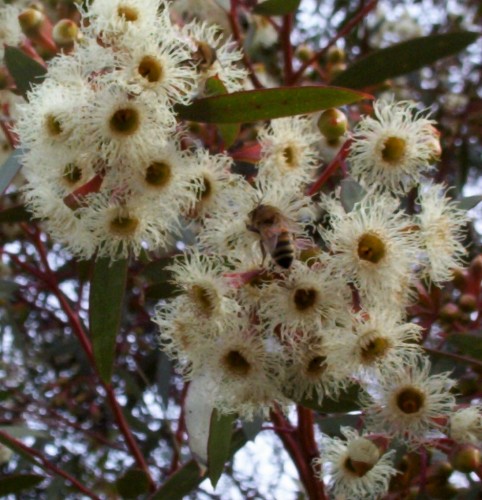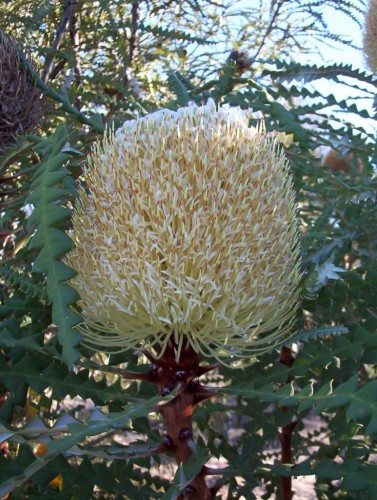Eucalyptus calycogona White (Square fruited Mallee)
This is the white form of Eucalyptus calycogona which is the subspecies ‘Eastern’. This is most likely to be found in the mallee district East of Adelaide across to the Victorian border. The photo is of a plant which is a street tree. It began flowering a few weeks ago and still has masses of buds still to open. The bees were very busy in clusters of flowers when I took this photo.
This is a mallee 2 to 6 metres tall. It seems to be a more vigorous plant than the subspecies calycogona pictured in the previous post. It is certainly taller and seems to have denser foliage. Both subspecies are frost hardy.
I think this must be the species that my friend would bring me each winter from the farm, not the subspecies from the previous post.
This information is from Dean Nicolle’s book ‘Eucalyptus of South Australia’. He has a collection of Eucalypts in an arboretum south east of Adelaide towards Victor Harbor.
Eucalyptus calycogona (Square-fruited Mallee)
This lovely flowering Eucalypt is Eucalyptus calycogona. This particular plant with the deep pink flowers is the one that was being given away as a memento of the Jubilee 150 celebrations in South Australia in 1986. It appears that this is subspecies calycogona as the white to pale pink form is called subspecies ‘Eastern’. I photographed this in a small planting up the road from here.
A friend living near the Victorian border brought me a bunch of the flowers from trees growing on their fence line each winter. In spite of thinking me wierd she persisted for many years with this offering until they retired into town. It grows well on the limestone here despite the fact that the books say ‘prefers heavy loams’.
Plant Photos Due Soon
At long last IT Whiz Son is in the process of helping me to put photos on the blog 😀 . He also showed me how to do these Smileys!
I offered the inducement, with tongue in cheek, of a chocolate cake by snail mail as a huge hint that I would like this. I was feeling envious of some of the lovely photos I was seeing on other blogs.
I hope to put occasional relevant photos on the posts particularly of plants flowering in the relevant season. For example many Hakeas and Eremophilas are coming into flower in the district. I am also trying to put together a collection of photos of local species in flower. Most of what I have is on 35mm film. I need to learn the art of dealing with scanned photos too until I am able to get some digital photos.
The trick is to have the photos of a size that does not take forever to download. Son feels he has achieved this.
Eriostemon (Philotheca) ‘Profusion’- Waxflower
I came across some articles on growing perfumed plants in the old ‘Growing Native Plants’ from Canberra Botanic Gardens.
One of the most delicious perfumes is the citrus style perfume of Eriostemon ‘Profusion’ (Waxflower) (now Philotheca ‘Profusion’). It is the leaves that have the perfume and brushing past the plant is sheer delight. I keep promising myself that I will put one on each corner of the garden beds where it is most likely to be brushed against. A lot of herb books suggest this technique of planting for the pleasure of the perfume in leaves.
I have found this plant to be remarkably hardy. It is growing on a limestone rubble mound of very high pH. The only thing going for it is the excellent drainage. It gets dappled shade most of the day. I take cutting material from it a couple of times a year. (It takes ages to strike.) It is a small rounded shrub with foliage well down the bush and it flowers all over the bush for months.
The species is in the same family as domestic citrus trees. The flowers are reminiscent of the flowers on lemon and orange trees in shape and form.
Banksia Cultivation
I have come to the conclusion that once the temperature reaches 0C that it doesn’t matter how much lower it gets. Cold is cold! We should be thankful, I suppose, that at least the temperature increases during the day to being quite pleasant, and of course with the intense cold we get these beautiful blue sky days.
The information on Banksias is truly incomplete. Many books will state categorically that particular species will grow only in acid soils. Until they are grown in soils of different pH and tested, we do only have this information to rely on.
I have updated this post with a photo of a Banksia I would like to grow at home. This one is at the Arboretum where pH is closer to neutral.
One of my aims is to try a variety of Banksias, using additional sulphur if necessary. I originally wanted to grow only those plants which grew well in highly alkaline soils. The problem is that I want to see good growth on all the plants and want to intervene if necessary. I will still have the restriction of rainfall to contend with any way. Record keeping is the key to making this a useful exercise.
I certainly want to have Banksia coccinea and Banksia menziesii in the garden.


